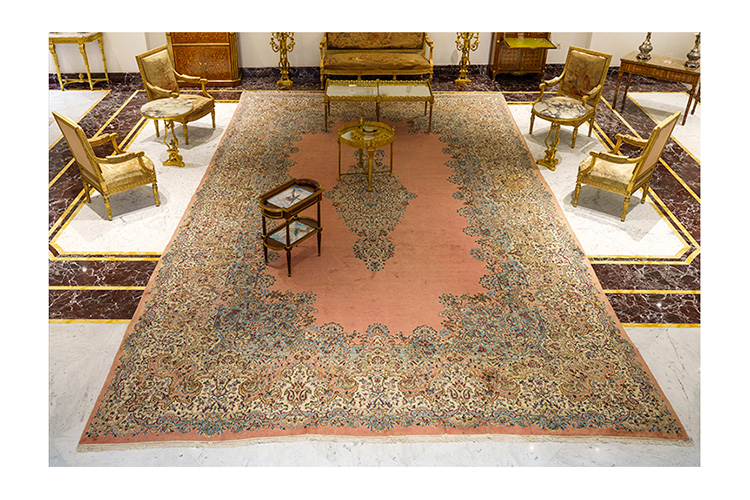![]()
Persijski tepih
Kerman Lawar, ancien
19. vek, dimenzije 675 x 410 cm
Ovaj carski antikni tepih iz Kermana i 19. veka pleten je ručno od čiste vune na osnovi od merserizovanog pamuka. Kerman je jedan od najvažnijih centara za izradu persijskih tepiha. Tu je Karim Kan Zand (1705‒1779), iz zandske dinastije, u carskim radionicama okupio najbolje zanatlije tradicionalnih tepiha koji su održali veštinu pletenja, ohrabrujući novine u dizajnu i boji. U toj radionici nastali su tzv. carski tepisi sa jedinstvenom, prostranom površinom lica, monumentalnim medaljonom na sredini i karakterističnom, dobro definisanom glavnom ivicom. Međutim, u ovom originalnom ostvarenju motiv je izuzetno izašao iz granica ivice i dosegao sredinu tepiha, a ugaoni motivi su zbog toga dobili istu tangentu. Delikatne ružice podsećaju nas da je ovaj tepih verovatno bio namenjen nekom od evropskih dvorova, pre svega francuskom plemstvu.
![]()
Persian carpet
Kerman Lawar, ancien
19th century, dimensions 675 x 410 cm
This antique imperial carpet from Kerman, dated 19 century, is hand-weaved from pure wool on a warp of mercerized cotton. Kerman was one of the most important je Persian carpet manufacture centres. This is where Karim Khan Zand (1705‒1779) from the Zand dynasty brough to his imperial workshops the best traditional carpet craftsmen who kept the skill of carpet-making alive, encouraging innovation in design and dye. This workshop is the place of origin of the so-called imperial carpets with singular, spacious front area, monumental medallion in the centre, and characteristic, well-defined main rim. However, in this original piece, the motif uncommonly grew out of the rim area and reached the centre of the carpet, which puts the corner motifs on the same tangent. The delicate roses tell us that this carpet was probably intended for some European court, most likely French nobility.
![]()
Tapis persan
Kerman Lawar, ancien
19e siècle, dimensions 675 x 410 cm
Ce tapis impérial antique de Kerman, du 19e siècle, est tissé à la main en pure laine sur une trame de coton mercerisé. Kerman est l’un des centres les plus importants pour la fabrication de tapis persans. Là, Karim Kan Zand (1705‒1779) de la dynastie Zand rassemble dans des ateliers impériaux les meilleurs artisans de tapis traditionnels qui maintiennent le savoir-faire du tissage, encourageant les innovations en matière de design et de couleur. Dans cet atelier on commence à fabriquer ce qu’on appelle les tapis impériaux avec une surface unique et spacieuse, avec un médaillon monumental au milieu et le bord principal caractéristique bien défini. Cependant, dans cette réalisation originale, le motif dépasse en grande partie les limites du bord et atteint le milieu du tapis; du coup, les motifs angulaires obtiennent la même tangente. Les roses délicates rappellent que ce tapis était probablement destiné à l’une des cours européenne, principalement à la noblesse française.
![]()
Персидский ковер
Kerman Lawar, ancient
XIX век, размеры 675 x 410 см
Этот имперский антикварный ковер от Кермана из 19. века – предмет ручной работы из чистой шерсти на основе мерсеризованного хлопка. Керман – один из важнейших центров изготовления персидских ковров. Именно здесь Карим Хан Занд (1705‒1779) из династии зандов собрал лучших мастеров традиционных ковров в имперских мастерских, которые сохранили искусство вязания, поощряя новизну в дизайне и цвете. В этой мастерской были созданы так называемые, императорские ковры с уникальной просторной лицевой поверхностью, монументальным медальоном посередине и характерным, четко очерченным основным краем. Однако в этой оригинальной реализации мотив чрезвычайно вышел за пределы края и достиг середины ковра, и поэтому угловые мотивы получили ту же касательную. Нежные розы напоминают нам, что этот ковер, вероятно, предназначался для одного из европейских дворов, прежде всего для французской знати.


